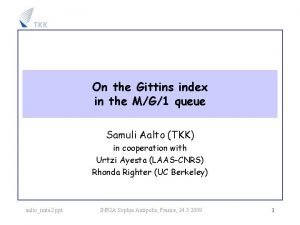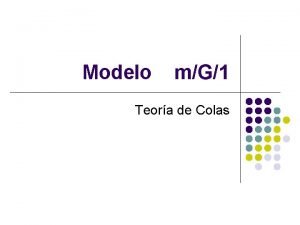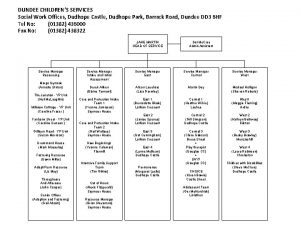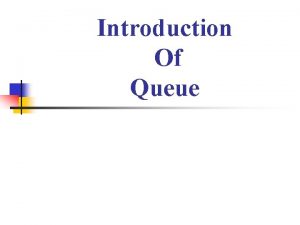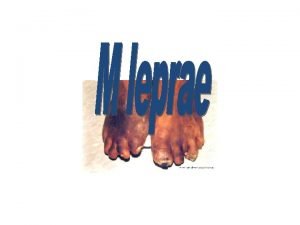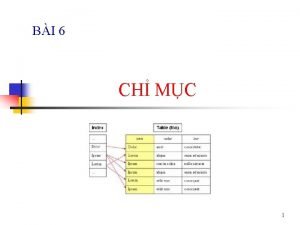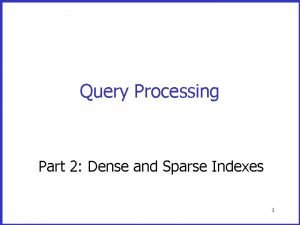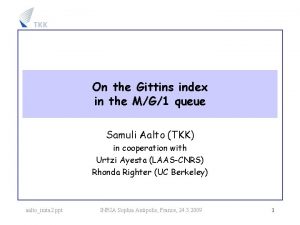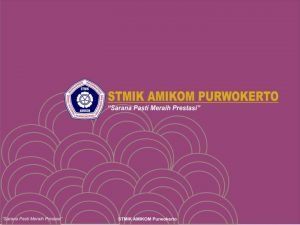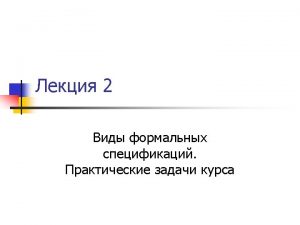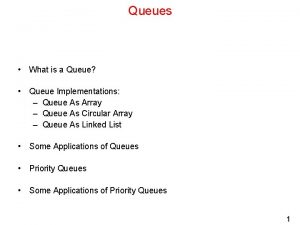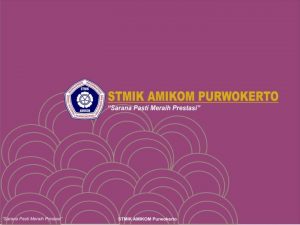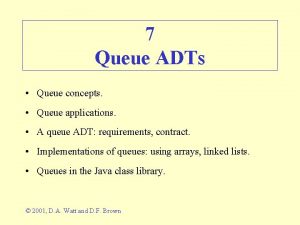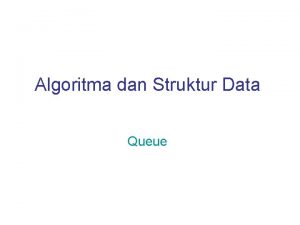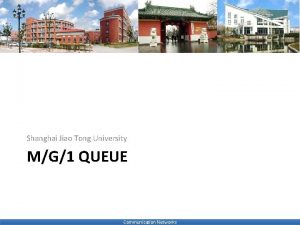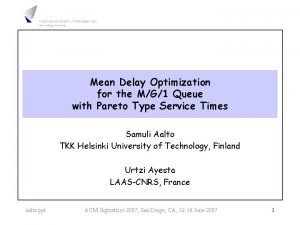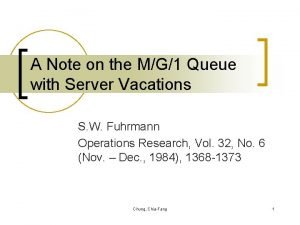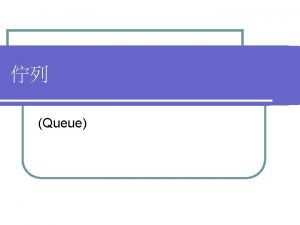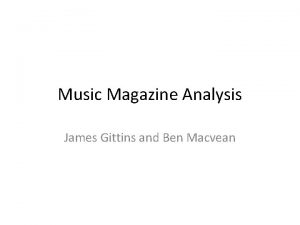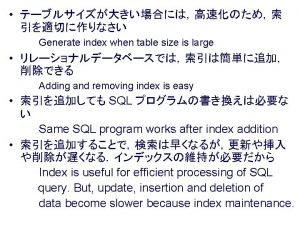On the Gittins index in the MG1 queue





![Service time distribution classes (1) • Service times are – IHR [DHR] if h(x) Service time distribution classes (1) • Service times are – IHR [DHR] if h(x)](https://slidetodoc.com/presentation_image_h/7ad6b56df3b09c705b883f8acd380b6d/image-6.jpg)











![DHR [IHR] service times • Lemma: • Proof: • Corollary: – If the service DHR [IHR] service times • Lemma: • Proof: • Corollary: – If the service](https://slidetodoc.com/presentation_image_h/7ad6b56df3b09c705b883f8acd380b6d/image-18.jpg)

![IMRL [DMRL] and NWUE [NBUE] service times • Lemma: • Proof: • Corollaries: – IMRL [DMRL] and NWUE [NBUE] service times • Lemma: • Proof: • Corollaries: –](https://slidetodoc.com/presentation_image_h/7ad6b56df3b09c705b883f8acd380b6d/image-20.jpg)


![Gittins index policy • Definition [Gittins (1989)]: – Gittins index policy gives service to Gittins index policy • Definition [Gittins (1989)]: – Gittins index policy gives service to](https://slidetodoc.com/presentation_image_h/7ad6b56df3b09c705b883f8acd380b6d/image-23.jpg)





- Slides: 28

On the Gittins index in the M/G/1 queue Samuli Aalto (TKK) in cooperation with Urtzi Ayesta (LAAS-CNRS) Rhonda Righter (UC Berkeley) aalto_inria 2. ppt INRIA Sophia Antipolis, France, 24. 3. 2009 1

Fundamental question • • It is well known that … … in the M/G/1 queue … among the non-anticipating scheduling disciplines … the optimal discipline is – FCFS if the service times are NBUE – FB if the service times are DHR • So, these conditions are sufficient for the optimality of FCFS and FB, respectively. But, … Are the conditions necessary? 2

Outline • • • Service time distribution classes Known optimality results Gittins index and service time distribution classes Gittins index policy New optimality results 3

Queueing model (1) • M/G/1 queue – Poisson arrivals with rate l – IID service times S with a general distribution – single server • Service time distribution: • Density function: • Hazard rate: 4

Queueing model (2) • Remaining service time distribution: • Mean remaining service time: • H-function: 5
![Service time distribution classes 1 Service times are IHR DHR if hx Service time distribution classes (1) • Service times are – IHR [DHR] if h(x)](https://slidetodoc.com/presentation_image_h/7ad6b56df3b09c705b883f8acd380b6d/image-6.jpg)
Service time distribution classes (1) • Service times are – IHR [DHR] if h(x) is increasing [decreasing] – DMRL [IMRL] if H(x) is increasing [decreasing] – NBUE [NWUE] if H(0) £ [³] H(x) • It is known that – IHR Ì DMRL Ì NBUE and DHR Ì IMRL Ì NWUE NBUE NWUE DMRL IHR DHR 6

Service time distribution classes (2) • IHR = Increasing Hazard Rate • DMRL = Decreasing Mean Residual Lifetime • NBUE = New Better than Used in Expectation • DHR = Decreasing Hazard Rate • IMRL = Increasing Mean Residual Lifetime • NWUE = New Worse than Used in Expectation NBUE NWUE DMRL IHR DHR 7

Outline • • • Service time distribution classes Known optimality results Gittins index and service time distribution classes Gittins index policy New optimality results 8

Scheduling/queueing/service disciplines • Anticipating: – SRPT = Shortest-Remaining-Processing-Time • strict priority according to the remaining service • Non-anticipating: – FCFS = First-Come-First-Served • service in the arrival order – FB = Foreground-Background • strict priority according to the attained service • a. k. a. LAS = Least-Attained-Service 9

Known optimality results • Among all scheduling disciplines, – SRPT is optimal (minimizing the queue length pathwise); Schrage (1968) • Among the non-anticipating scheduling disciplines, – FCFS is optimal for NBUE service times (minimizing the mean queue length); Righter, Shanthikumar and Yamazaki (1990) – FB is optimal for DHR service times (minimizing the queue length stochastically); Righter and Shanthikumar (1989) NBUE DMRL IHR NWUE IMRL DHR 10

Our objective • We will show that … • … among the non-anticipating scheduling disciplines – FCFS is optimal only for NBUE service times – FB is optimal only for DHR service times • In other words, we will show that … Yes, the conditions are necessary. • For that, we need The Gittins Index 11

Outline • • • Service time distribution classes Known optimality results Gittins index and service time distribution classes Gittins index policy New optimality results 12

Gittins index • Efficiency function (J-function): • Gittins index for a customer with attained service a: • Optimal (individual) service quota: 13

Example Pareto service time distribution starting from 1 k=1 D*(0) = 3. 732 14

Basic properties (1) • Partial derivative w. r. t. to D: • Lemma: – If D*(a) < ¥ and h(x) is continuous, then 15

Basic properties (2) • Lemma: • Corollary: 16

Outline • • • Service time distribution classes Known optimality results Gittins index and service time distribution classes Gittins index policy New optimality results 17
![DHR IHR service times Lemma Proof Corollary If the service DHR [IHR] service times • Lemma: • Proof: • Corollary: – If the service](https://slidetodoc.com/presentation_image_h/7ad6b56df3b09c705b883f8acd380b6d/image-18.jpg)
DHR [IHR] service times • Lemma: • Proof: • Corollary: – If the service times are DHR [IHR], then J(a, D) is decreasing [increasing] w. r. t. to D for all a, D. • Corollary: – If the service times are DHR [IHR], then G(a) = h(a) [H(a)] for all a. 18

DHR service times • Proposition: – (i) The service times are DHR if and only if (ii) G(a) is decreasing for all a. – In this case, G(a) = h(a) for all a. • Proof: – (i) Þ (ii): Corollary in slide 18 – (ii) Þ (i): Corollary in slide 16 19
![IMRL DMRL and NWUE NBUE service times Lemma Proof Corollaries IMRL [DMRL] and NWUE [NBUE] service times • Lemma: • Proof: • Corollaries: –](https://slidetodoc.com/presentation_image_h/7ad6b56df3b09c705b883f8acd380b6d/image-20.jpg)
IMRL [DMRL] and NWUE [NBUE] service times • Lemma: • Proof: • Corollaries: – The service times are IMRL [DMRL] if and only if J(a, ¥) £ [³] J(a, D) for all a, D. – The service times are NWUE [NBUE] if and only if J(0, ¥) £ [³] J(0, D) for all D. 20

DMRL and NBUE service times • • Proposition: – (i) The service times are DMRL if and only if (ii) G(a) is increasing for all a if and only if (iii) G(a) = H(a) for all a. – (i) The service times are NBUE if and only if (ii) G(a) ³ G(0) for all a if and only if (iii) G(0) = H(0). Proof: – (i) Û (iii) Þ (ii): Corollary in slide 20 – (ii) Þ (i): Corollary/Lemma in slide 16 21

Outline • • • Service time distribution classes Known optimality results Gittins index and service time distribution classes Gittins index policy New optimality results 22
![Gittins index policy Definition Gittins 1989 Gittins index policy gives service to Gittins index policy • Definition [Gittins (1989)]: – Gittins index policy gives service to](https://slidetodoc.com/presentation_image_h/7ad6b56df3b09c705b883f8acd380b6d/image-23.jpg)
Gittins index policy • Definition [Gittins (1989)]: – Gittins index policy gives service to the job i with the highest Gittins index Gi(ai). • Theorem [Gittins (1989), Yashkov (1992)]: – Among the non-anticipating disciplines, Gittins index policy minimizes the mean queue length in the M/G/1 queue (with possibly multiple job classes) • Observations: – FB is a Gittins index policy if and only if G(a) is decreasing for all a. – FCFS (or any other non-preemptive policy) is a Gittins index policy if and only if G(a) ³ G(0) for all a. 23

Outline • • • Service time distribution classes Known optimality results Gittins index and service time distribution classes Gittins index policy New optimality results 24

Single job class (1) • Theorem: – FB minimizes stochastically the queue length if and only if the service times are DHR. • Proof: – Theorem in slide 23 and Proposition in slide 19 together with Righter, Shanthikumar and Yamazaki (1990). • Theorem: – FCFS minimizes the mean queue length if and only if the service times are NBUE. • Proof: – Theorem in slide 23 and Proposition in slide 21. 25

Single job class (2) • Additional assumption: – arriving jobs have already attained a random amount of service elsewhere • Theorem: – FB = LAS minimizes the mean queue length if and only if the service times are DHR. • Definition: – MAS (Most-Attained-Service) gives service to the job i with the highest hazard rate hi(ai). • Theorem: – MAS minimizes the mean queue length if and only if the service times are DMRL. 26

Multiple job classes • Additional assumption: – arriving jobs have already attained a random amount of service elsewhere • Definition: – HHR (Highest-Hazard-Rate) gives service to the job i with the highest hazard rate hi(ai). • Theorem: – If all service time distributions are DHR, then HHR minimizes the mean queue length • Theorem: – If all service time distributions are DMRL, then SERPT minimizes the mean queue length 27

THE END 28
 Gittins index table
Gittins index table Modelo mg1
Modelo mg1 Gittins age patriarchy
Gittins age patriarchy Dundee social work
Dundee social work Input restricted deque
Input restricted deque Eryhtema
Eryhtema Liquid limit of soil formula
Liquid limit of soil formula Pqli advantages and disadvantages
Pqli advantages and disadvantages Clustered index và non clustered index
Clustered index và non clustered index Diff between step index and graded index fiber
Diff between step index and graded index fiber Fibers
Fibers Primary index is dense or sparse
Primary index is dense or sparse Simpson's diversity index table
Simpson's diversity index table Thế nào là hệ số cao nhất
Thế nào là hệ số cao nhất Ng-html
Ng-html Sơ đồ cơ thể người
Sơ đồ cơ thể người Số.nguyên tố
Số.nguyên tố Tư thế ngồi viết
Tư thế ngồi viết đặc điểm cơ thể của người tối cổ
đặc điểm cơ thể của người tối cổ Cách giải mật thư tọa độ
Cách giải mật thư tọa độ Tư thế worm breton là gì
Tư thế worm breton là gì ưu thế lai là gì
ưu thế lai là gì Thẻ vin
Thẻ vin Cái miệng bé xinh thế chỉ nói điều hay thôi
Cái miệng bé xinh thế chỉ nói điều hay thôi Thơ thất ngôn tứ tuyệt đường luật
Thơ thất ngôn tứ tuyệt đường luật Các châu lục và đại dương trên thế giới
Các châu lục và đại dương trên thế giới Từ ngữ thể hiện lòng nhân hậu
Từ ngữ thể hiện lòng nhân hậu Bổ thể
Bổ thể Tư thế ngồi viết
Tư thế ngồi viết
